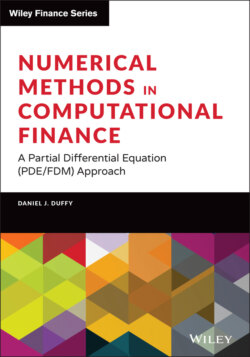Читать книгу Numerical Methods in Computational Finance - Daniel J. Duffy - Страница 51
3.2 EXISTENCE AND UNIQUENESS RESULTS
ОглавлениеWe turn our attention to a more general initial value problem for a non-linear system of ODEs:
(3.1)
where:
Some of the important questions to be answered are:
Does System (3.1) have a unique solution?
In which interval does this solution exist?
What is the asymptotic behaviour of the solution as ?
To this end, let B be a region of dimensional space, and let f be continuously differentiable with respect to t and with respect to all the components of y at all points of B. We assume that the following inequalities hold:
(3.2)
and:
(3.3)
Theorem 3.1 Let f and be continuous in the box where a and b are positive numbers and satisfying the bounds (3.2) and (3.3) for (t, y) in B. Let be the smaller of the numbers a and b/M and define the successive approximations:
(3.4)
Then the sequence of successive approximations converges (uniformly) in the interval to a solution of (3.1) that satisfies the initial condition .
Method (3.4) is called the Picard iterative method and it is used to prove the existence of the solution of systems of ODE (3.1). It is mainly of theoretical value, as it should not necessarily be seen as a practical way to construct a numerical solution. However, it does give us insights into the qualitative properties of the solution. On the other hand, it is a useful exercise to construct the sequence of iterates in Equation (3.4) for some simple cases.
We note that the IVP (3.1) can be written as an integral equation as follows:
(3.5)
It can be proved that the solution of (3.1) is also the solution of (3.5) and vice versa. We see then that Picard iteration is based on (3.5) and that we wish to have the iterates converging to a solution of (3.5).
We note that the Picard method is used primarily to prove the existence of solutions and it is not a numerical method as such.
